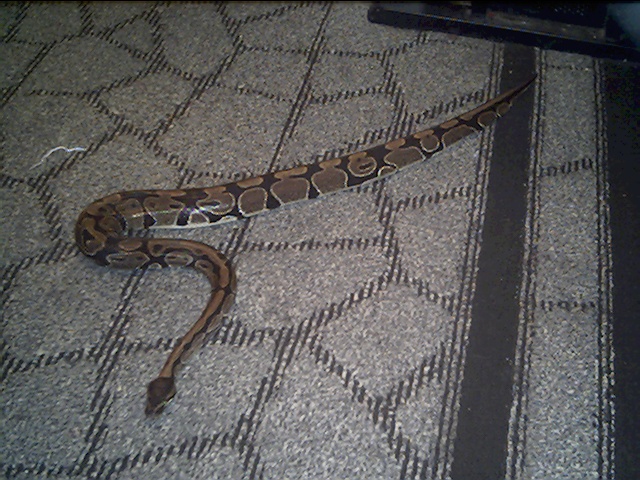| Home Page
Photo Page
Photo2 Page
Ball Python care
African Rock Python care
Red tail Boa care
Burmese Python care
Guest Book Page
Contact Page
|
|
Natural History
Ball pythons (Python regius) are found at the edges of the forest lands of Central and Western Africa. They are equally comfortable on the ground and in trees. They are crepuscular, active around dawn and dusk. Called royal pythons in Europe, here in the United States we call them "balls" due to their habit of curling themselves up into a tight ball when they are nervous, their heads pulled firmly into the center. Like most pythons, ball pythons are curious and gentle snakes.
|
 This is one of my favorite images
This is my good friend Hal. I took this picture on his birthday. I think he likes to be in pictures.
This is one of my favorite images
This is my good friend Hal. I took this picture on his birthday. I think he likes to be in pictures. |
|
Provide a hiding place
A half-log is available at pet stores. An empty cardboard box or upside-down opaque plastic container, both with an access doorway cut into one end, can also be used. The plastic is easily cleaned when necessary; the box can be tossed out when soiled and replaced with a new one. The box or log must be big enough for the snake to hide its entire body inside; you will need to eventually replace it as your snake grows. Ball pythons prefer dark places for sleeping and, as they are nocturnal, they like the dark place during our daylight hours; they also like to sleep in something that is close around them, so do not buy or make too big of a cave for its size. Place a nice climbing branch or two in the tank with some fake greenery screening part of it; your ball will enjoy hanging out in the "tree."
|
|
Feeding
Allow your snake to acclimate to its new home for a couple of weeks. Start your hatchling (about 15" in length) off with a single pre-killed one week to 10-day old "fuzzy" mouse. A smaller sized hatchling may require a smaller mouse; try a pre-killed 5-day old. Older ball pythons may be fed larger pre-killed mice or pinkie rats. If you have not had any experience force feeding a snake, you may not want to try it yourself until you have seen someone do it. Force feeding, whether of a mouse or with a formula inserted by catheter and syringe, is very stressful for the snake (and it isn't much fun for the owner!). If your new ball has gone several months without eating and is beginning to noticeably lose weight, take it to a reptile vet or contact your local herpetology society and ask to speak to someone who is knowledgeable about ball pythons and feeding problems. A good inexpensive book that covers some of the tricks to enticing reluctant ball pythons to feed is The Care and Maintenance of Ball Pythons by Philippe de Vosjoli, or the new edition, The Ball Python Manual, by de Vosjoli, Dave and Tracy Barker and Roger Klingenberg.
Water
Provide a bowl of fresh water at all times. Your snake will both drink and soak, and may defecate, in it. Check it daily and change when soiled. Soaking is especially good just before a shed. When they eyes clear from their milky opaque, or "blue" state, soak the snake in a tub of warm water for ten minutes or so, then lightly dry it off, and return it immediately to its tank; it should shed cleanly within twenty-four hours.
|
 Keeping it warm
Proper temperature range is essential to keeping your snake healthy. The ambient air temperature throughout the enclosure must be maintained between 80-85F (27-29 C)-during the day, with a basking area kept at 90F (32.5 C). At night, the ambient air temperature on the coolest side may be allowed to drop down no lower than 73-75F ( 23-24 C) only if a basking area of at least 80F (27 C) remains available. Special reptile heating pads that are manufactured to maintain a temperature about 20 degrees higher than the air temperature may be used inside the enclosure. There are adhesive pads that can be stuck to the underside of a glass enclosure. Heating pads made for people, available at all drug stores, are also available; these have built-in hi-med-lo switches and can be used under a glass enclosure. You can also use incandescent light bulbs in porcelain and metal reflector hoods to provide the additional heat required for the basking area. All lights must be screened off to prevent the snake from burning itself. All pythons, especially ball pythons, are very susceptible to thermal burns. For this same reason do not use a hot rock. New on the market are ceramic heating elements. They radiate heat downwards, do not emit light, and are reported to be
Keeping it warm
Proper temperature range is essential to keeping your snake healthy. The ambient air temperature throughout the enclosure must be maintained between 80-85F (27-29 C)-during the day, with a basking area kept at 90F (32.5 C). At night, the ambient air temperature on the coolest side may be allowed to drop down no lower than 73-75F ( 23-24 C) only if a basking area of at least 80F (27 C) remains available. Special reptile heating pads that are manufactured to maintain a temperature about 20 degrees higher than the air temperature may be used inside the enclosure. There are adhesive pads that can be stuck to the underside of a glass enclosure. Heating pads made for people, available at all drug stores, are also available; these have built-in hi-med-lo switches and can be used under a glass enclosure. You can also use incandescent light bulbs in porcelain and metal reflector hoods to provide the additional heat required for the basking area. All lights must be screened off to prevent the snake from burning itself. All pythons, especially ball pythons, are very susceptible to thermal burns. For this same reason do not use a hot rock. New on the market are ceramic heating elements. They radiate heat downwards, do not emit light, and are reported to be |
Handling your new snake
After giving your ball a couple of days to settle in, begin picking it up and handling it gently. It may move away from you, and may threaten you by lashing it's tail and hissing; don't be put off - it is usually just a bluff, and snakes, like most reptiles, are very good at bluffing! Be gentle but persistent. Daily contact with each other will begin to establish a level of trust and confidence between you and your snake. When it is comfortable with you, you can begin taking it around the house. Don't get overconfident! Given a chance and close proximity to seat cushions, your ball will make a run (well, a slither) for it, easing down between the cushions and from there, to points possibly unknown. Always be gentle, and try to avoid sudden movements. If the snake wraps around your arm or neck, you can unwind it by gently grasping it's tail and gently unwrapping it from around your neck or arm - do not try to unwrap it by moving the head. Some snakes are a bit sensitive about being handled soon after they have eaten. If you feed your snake out of it's enclosure, go ahead and replace it back into it's enclosure after it has finished eating. Then leave it be for a couple of days. As the snake gets more comfortable with you, it will be less nervous and less likely to give you back your mouse. |
|
|
